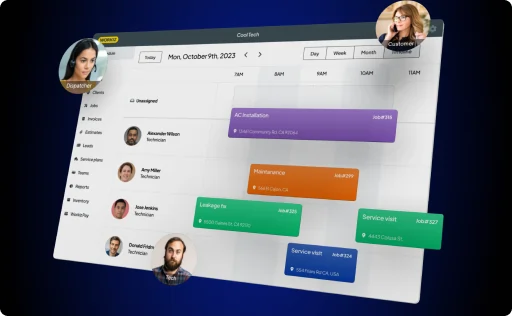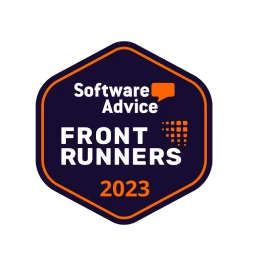But things may eventually work out and even scale to the point when you have many clients and many jobs to do. That’s usually the phase in which a company needs to optimize its processes. Luckily, the dispatching process is among the easiest to improve, mostly because in the 21st century, there are so many ways to automate it. Some of them may even save you money on other expenses, such as marketing.
Take Dany, for instance. Dany Appliance Repairs, whose team uses Workiz software to manage their business, has prevented spending too much money on Google Ads because of effective call queues (we’ll explain what it is in a minute). Google Ads is a great way to reach out to more clients, but that strategy won’t necessarily get you more jobs. On the other hand, Call queuing will make job scheduling easy and convenient and cost you far less than advertising.
So what are call queues?
Imagine you have a very busy day. If you’re an HVAC pro, that might be the beginning of the summer. If you’re a junk removal pro, that might be the 5th of July. During those days, it was nearly impossible to answer every single client who calls you personally. You might find yourself putting them on hold or, god forbid, miss the call. Even if you hire someone to answer calls for you, that person might miss out on calls simply because they can only answer a few calls every given time or merely because the inquiries were received at an unusual hour.
That’s where call queueing comes in. Call queuing means placing your clients in a queue so that they’ll know whether or when their call will be answered.
How it works
As a customer of many services, you already know how it feels to call a business and choose the number related to the category of services you need.
These queues work by dividing the incoming calls into categories and assigning a call queue to each category. That way, the call is answered by the first available agent.
What will prevent my clients from abandoning the queue?
Indeed, one of the disadvantages of call queues is that they are prone to abandonment, especially if you’re told the expected waiting time is over five minutes. However, home services businesses can do a few things to reduce the abandonment rate in their call center:
- Provide a live chat option for those who are not waiting for an agent
- Allow callers to schedule a callback
- Offer the opportunity to email an agent
- Allow callers to submit their information for future assistance
- Offer the option to ask a question over the phone and then add the caller to the queue to call back
Why not just hire more people to handle my calls?
One answer is for customer callbacks. Call queues allow the service company to have staggered phone lines and place agents so that there are never any “no one answers the phone” issues. When a customer calls in with an emergency, one agent is behind the desk answering emergency calls. The caller who placed the call in the queue is notified and can be called back within a specified time interval.
That way, setting up a queue system ahead of time should save the customer the worry of not getting help because of the staggering hours of operation. Plus, the agent answering the phone will most likely get to the customer a few minutes into the queue, ensuring the customer won’t call a different service provider.
How many more clients would a call queue system make servable to the field service business?
A call queue system would make servable about 100 more clients per day to a field service business. That’s a hundred more jobs to handle. You figure out the potential revenue.
How long would it take for the caller to receive a callback after they reach the “no one to answer the phone” hours?
While your staff gets some rest and sleep, a call queuing system doesn’t. If a customer reaches our “no one to answer the phone” hours during the day, they will receive a call back quickly, depending on what time of day it is. If the incident is during the night, they would be in the queue and receive a callback as soon as the receptionist on duty’s shift has a break. At this point, work hours would have more flexibility, and callbacks are made instantaneously.
Should I still have a voicemail?
Voicemail is an essential component of any call ticketing or call queuing management system, and it can improve the customer experience.
Tip: Use a phone system like Workiz that transcribes voice messages and automatically imports the client’s address, phone number, etc., into your CRM records.
Can I also view analytics and reporting?
Of course! Once you use a phone system with a call queue and stored data, you can analyze the data. You can see how callers are handled, how many calls were answered, and how long it takes for your employees to pick up. If an agent is unavailable, you’ll see how long the wait was before the callers were put on hold and how long they were on hold. Through analyzing the data, you’ll know who the most efficient representatives are, which representatives are frequently unavailable, how long the customers have been waiting and how often personal questions are being answered. All of it means a great deal in terms of optimizing your business operations, not to mention the way you value and compensate your employees.
How to operate the Workiz call queue system?
Workiz has a detailed and easy 5-step process to create your call queue to improve customer service. The process is as follows:
- Define your call handling activity: are you handling inbound, outbound, or both?
- Determine the maximum number of employees handling calls at any given time: Do you want your staff to manage a maximum of 10 inbound calls/hour? 20?
- Determine dispatcher requirements: headset/physical phone
- Continually analyze call traffic to fine-tune queues:
- Adjust the rules as necessary.
Want to give us a try?
Contact us, and we’ll walk you through the installation process. What do you have to lose?
Fill in your details here or at the bottom of this page.










